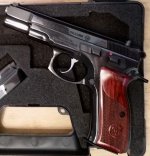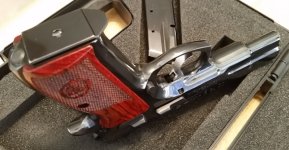Glocks and SIGs often show holster wear more obviously than do CZs. Some folks consider these marks to be "character" and don't worry about it. Unless you send them back to Glock or SIG, there's not much else you can do.
With CZs wearing polycoat, a matte black auto-body touch-up paint can be used to fix chips or scratches. The paint in the small bottles of touch-up paint seem to be thicker than is best; I've found that a can of Dupli-color matte black sprayed onto a piece of aluminum foil, but applied to the gun using a fine model paint brush does beautifully. You'll find that you can fix most imperfections so that they really are hard to see. (It also worked with a 2000 series Sphinx I once had, with a small scratch on the slide.)
At one time CZ had this on their website, but I don't know if it's still there. As noted, elsewhere, the polycoated guns also have a manganese phosphate (Parkerized) undercoating, too. The polycoat finish has evolved over the years. Early versions (not the crappy enamel on the older CZ-75s) were easily damaged by some solvents, like brake clearner, but that is no longer the case.
Q: "What is the finish called "Black polymer"
A: Black polymer is electrostaticly applied powder coating that is then oven cured to a hard shell. The coating is applied over a Parkerized or Phosphate finish which is very corrosion resistant in itself, the parts are then racked and given a negative charge and sprayed at the guns components. This charged attraction literally draws the coating to the parts, this gives the parts a uniform finish and reduces overspray. The parts are cured in a oven and this produces a tough Mil. spec. finish.
My favorite CZ finish is the Satin Nickel -- I have an 85 Combat wearing that finish.


